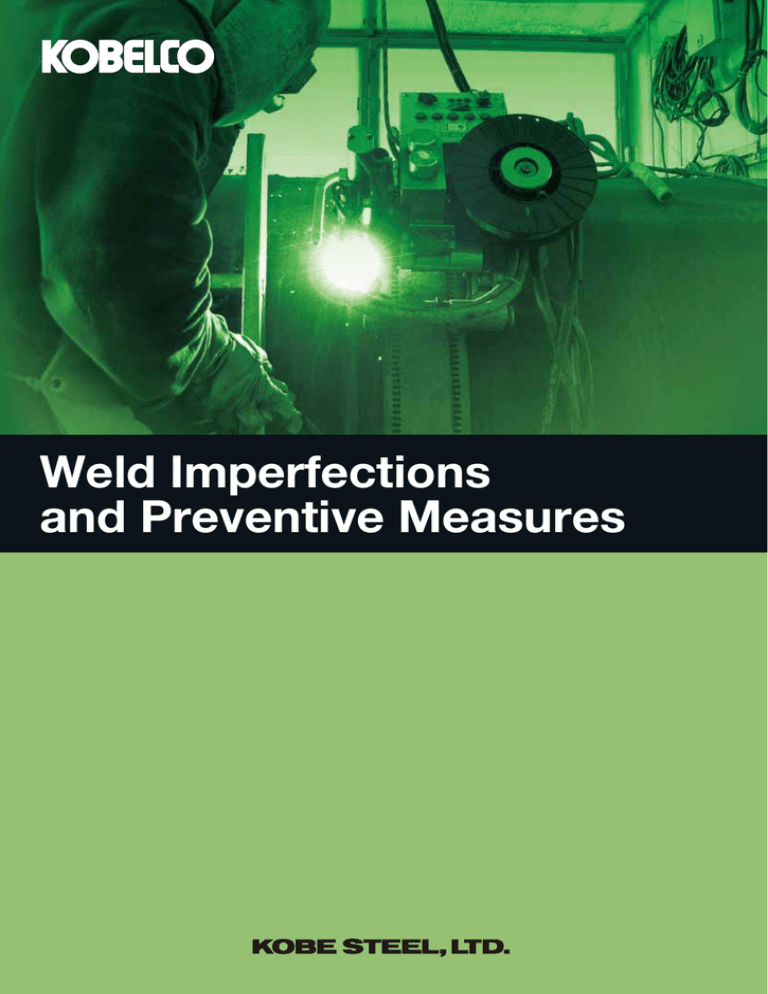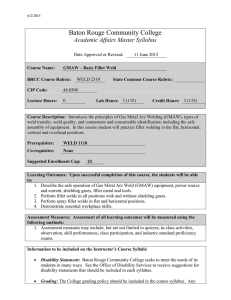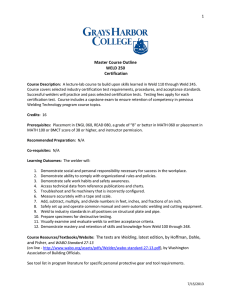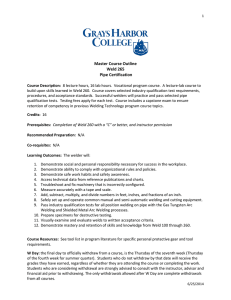
Weld Imperfections
and Preventive Measures
Weld Imperfections
and Preventive Measures
Published by KOBE STEEL, LTD.
© 2015 by KOBE STEEL, LTD.
5-912, Kita-Shinagawa, Shinagawa-Ku, Tokyo
141-8688 Japan
All rights reserved. No part of this book may be
reproduced, in any form or by any means, without
permission in writing from the publisher.
The Weld Imperfections and Preventive Measures
provides information to assist welding personnel study
the arc welding technologies applied in steel
fabrication.
Reasonable care is taken in the compilation and
publication of this textbook to insure authenticity of
the contents. No representation or warranty is made as
to the accuracy or reliability of this information.
Introduction
In the construction of such steel structures as buildings and bridges and the fabrication of
such machinery as ships, autos, rolling stock, and pressure vessels, arc welding is the
indispensable method for joining metals. Therefore, the reliability of steel structures and
machinery depends on the quality of the welds as well as the quality of the steel materials. In
order to produce satisfactory weldments which fulfill the requirements of quality, the integrity
of quality control is very important. For integral quality control, all the personnel (including
managers, engineers, inspectors, supervisors, foremen, welders, and welding operators) who
are involved in arc welding should have adequate knowledge of weld imperfections and
preventive measures. This booklet, Weld Imperfections and Preventive Measures, is prepared
to provide the information of common weld imperfections, causes, and preventive measures.
The weld imperfections contained in this textbook are categorized into surface
irregularities and weld discontinuities. Surface irregularities can be defined as "weld surface
conditions that contain notches or abrupt changes in thickness or appearance." Surface
irregularities include uneven weld bead ripples, excessive weld reinforcement, excessively
concave or convex fillet welds, uneven-leg fillet welds, undercut, overlap, herringbone,
pockmarks, mouse footmarks, and underfill. Weld discontinuities can be defined as "an
interruption of the typical structure of a weld, such as a lack of homogeneity in the mechanical,
metallurgical or physical characteristics of the weld." Weld discontinuities include porosity,
slag inclusions, incomplete fusion, incomplete joint penetration, excessive melt-through, cold
cracks, and hot cracks. However, a surface irregularity or weld discontinuity is not a rejectable
defect when it is within the permissible range of extent according to the relevant specification.
This textbook has been edited by employing as many photographs and drawings as possible
in order to help the learners fully understand specific technologies of arc welding and related
weld imperfections. The information contained in this textbook includes those derived from
the reference books listed below.
References
(1) Kobe Steel, Ltd., "Welding Electrode Handbook," 1964
(2) Japan Welding Engineering Society, "Typical Weld Photographs," 1967, Sanpo Publications Inc.
(3) Japan Cultural and Industrial Promotion Co. Ltd., "Photographic Welding," 1961
(4) Overseas Vocational Training Association, "Arc Welding," 1985
(5) American Welding Society, "Welding Handbook," 8th Edition, Vol. 1, 1987
(6) American Welding Society, "Jefferson's Welding Encyclopedia," 18th Edition, 1997
(7) American Welding Society, "Weld and Base Metal Discontinuities," 1986
iii
Contents
Surface irregularities
1
Fig. 1 — Uneven weld bead ripples
Fig. 2 — Excessive weld reinforcement
Fig. 3 — Concave fillet weld, Convex fillet weld
Fig. 4 — Uneven-leg fillet weld
Fig. 5 — Undercut
Fig. 6 — Overlap
Fig. 7 — Herringbone, Pock mark, Mouse footmark
Fig. 8 — Underfill (Internal concavity)
Weld discontinuities
9
Fig. 9 — Porosity (Pit)
Fig. 10 — Porosity (Blowhole)
Fig. 11 — Slag inclusions
Fig. 12 — Incomplete fusion
Fig. 13 — Incomplete joint penetration
Fig. 14 — Excessive melt-through (Burn-through)
Fig. 15 — Cold crack (Root crack, Toe crack, Underbead crack, Transverse crack)
Fig. 16 — Cold crack (Lamellar tear)
Fig. 17 — Hot crack (Crater crack, Longitudinal crack, Pear-shape crack, Sulfur crack)
Appendix A
18
Fig. A-1 Rupture in welds caused by weld imperfections (Bend test results of weld joints)
Fig. A-2 Rupture in welds caused by weld imperfections (Tensile test results of weld joints)
v
— Surface Irregularity —
SMAW
SAW
Fig. 1 UNEVEN WELD BEAD RIPPLES
Definition: Abrupt changes in the profiles of weld bead ripples
Main Causes:
(1) Too low or high welding amperage or voltage
(2) Inappropriate electrode manipulation
(irregular, too fast, or too slow)
(3) Too much moisture in coatings (SMAW) or fluxes (SAW)
(4) Too much flux-burden height (SAW)
Preventive Measures:
(1) Use proper welding amperages and voltages.
(2) Manipulate electrodes at appropriate speeds.
(3) Redry coatings and fluxes.
(4) Use a proper flux-burden height.
1
— Surface Irregularity —
SAW
GTAW
Narrow
weaving width
Appropriate
weaving width
Wide
weaving width
Fig. 2 EXCESSIVE WELD REINFORCEMENT
Definition: The face or root reinforcement that has a larger height
than that specified
Main Causes:
(1) Too slow electrode manipulation
(2) Too much root opening (root reinforcement)
(3) Too much welding amperage (root reinforcement)
Preventive Measures:
(1) Manipulate electrodes at appropriate speeds.
(2) Adjust root opening.
(3) Use appropriate welding amperages.
(4) Control the electrode displacement (see the above drawings).
2
— Surface Irregularity —
(A) Good fillet weld
(B) Concave fillet weld
(C) Convex fillet weld
Fig. 3 CONCAVE FILLET WELD, CONVEX FILLET WELD
Definition: A fillet weld that has excessive concavity or convexity
Main Causes:
(1) Too fast electrode manipulation, using too high
welding amperage (Concave fillet weld)
(2) Too low welding amperage or
too slow electrode manipulation (Convex fillet weld)
(3) Electrode travel angle is inappropriate.
Preventive Measures:
Use appropriate welding amperages and electrode manipulation speeds
with an appropriate travel angle.
3
— Surface Irregularity —
(B) Even-leg fillet weld
in horizontal position
(A) Uneven-leg fillet weld
in horizontal position
Appropriate electrode work angle
Fig. 4 UNEVEN-LEG FILLET WELD
Definition: A fillet weld that has uneven legs
(the upper leg is often smaller than the lower leg)
Main Causes:
Electrode work angle is inappropriate.
Preventive Measures:
Use an appropriate electrode work angle (see the above drawings).
4
— Surface Irregularity —
Flat-position groove weld
Horizontal fillet weld
Horizontal fillet weld
Fig. 5 UNDERCUT
Definition: A groove that is gouged in the base metal adjacent
to the weld toe or weld root and is left unfilled by the weld metal
Main Causes:
(1) Too high welding amperage
(2) Too fast electrode manipulation
(3) Too long arc length, or too high arc voltage
(4) Electrode travel and work angles are inappropriate.
(5) The wire tracking is too close to the groove face (SAW)
Preventive Measures:
(1)-(4) Use appropriate welding amperages, electrode manipulation speeds,
arc lengths (or arc voltages), and electrode travel and work angles.
(5) Adjust the wire tracking location.
5
— Surface Irregularity —
Butt weld in horizontal vertical position
Fillet weld in horizontal position
Fig. 6 OVERLAP
Definition: The protrusion of weld metal beyond the weld toe or weld root
Main Causes:
(1) Too low welding amperage
(2) Too slow electrode manipulation
(3) Too short arc length, or too low arc voltage
(4) Electrode travel and work angles are inappropriate.
Preventive Measures:
Use appropriate welding amperages, manipulation speeds,
arc lengths (arc voltages), and electrode travel and work angles.
6
— Surface Irregularity —
Herringbone in SAW weld
Pock mark in SAW weld
Mouse footmark in SMAW weld
Fig. 7 HERRINGBONE, POCK MARK, MOUSE FOOTMARK
Definition: Shallow indentations on the surface of a weld
Main Causes:
(1) Moisture in coatings (SMAW) or fluxes (SAW)
(2) Rust, paint, or moisture on the joint fusion faces
Preventive Measures:
(1) Redry the coatings (SMAW) and fluxes (SAW).
(2) Remove rust, paint, and moisture from the joint fusion faces.
7
— Surface Irregularity —
SMAW
Top
5G Pipe
Bottom
(C)
Wide weaving width
(B)
Appropriate weaving width
(A)
Narrow weaving width
Fig. 8 UNDERFILL (INTERNAL CONCAVITY)
Definition: A depression on the weld face or root surface
extending below the adjacent surface of the base metal
Main Causes:
(1) Too small root opening, groove angle, or too much root face
(2) Too low amperage, or too long arc
(3) Inappropriate electrode manipulation
Preventive Measures:
(1) Adjust the root opening, groove angle, and root face.
(2) Use appropriate welding amperages and keep the arc length short.
(3) Use the suitable electrode manipulation as shown in the above drawings.
8
— Weld Discontinuities —
SMAW
GMAW
SAW
Fig. 9 POROSITY (PIT)
Definition: Cavity type discontinuities formed by gas entrapment during solidification
of weld metal
Main Causes:
(1) Rust, oil, paint, or moisture on the joint fusion faces and
high sulfur content of the base metal
(2) Moisture in coatings (SMAW), fluxes (SAW), or shielding gases (GMAW)
(3) Too little shielding gas (GMAW) or flux-burden height (SAW)
(4) Strong wind (SMAW, GMAW)
(5) Too much welding amperage, arc length, or arc voltage
Preventive Measures:
(1) Clean the joint fusion faces.
(2) Redry coatings (SMAW) and fluxes (SAW) and
use suitable shielding gases (GMAW).
(3) Use proper amounts of shielding gas (GMAW) and flux-burden height (SAW).
(4) Use a wind screen (SMAW, GMAW).
(5) Use appropriate welding amperages, arc lengths, and arc voltages.
9
— Weld Discontinuities —
X-Ray Test
Fracture Test
Fig. 10 POROSITY (BLOWHOLE)
Definition: Cavity type discontinuities formed by gas entrapment during solidification of
weld metal
Main Causes:
(1) Rust, oil, paint, or moisture on the joint fusion faces and
high sulfur content of the base metal
(2) Moisture in coatings (SMAW), fluxes (SAW), or shielding gases (GMAW)
(3) Too little shielding gas (GMAW) or flux-burden height (SAW)
(4) Strong wind
(5) Too much welding amperage, arc length, or arc voltage
Preventive Measures:
(1) Clean the joint fusion faces.
(2) Redry coatings (SMAW) and fluxes (SAW) and
use suitable shielding gases (GMAW).
(3) Use proper amounts of shielding gas (GMAW) and flux-burden height (SAW).
(4) Use a wind screen (SMAW, GMAW).
(5) Use appropriate welding amperages, arc lengths, and arc voltages.
10
— Weld Discontinuities —
X-Ray Test
Fig. 11 SLAG INCLUSIONS
Definition: Nonmetallic solid materials entrapped in weld metals
or between weld metal and base metal
Main Causes:
(1) Too low welding amperage
(2) Too much arc length
(3) Too much weaving width
(4) Too narrow groove
(5) Slag that remains on the preceding layer
(6) Inclined weld axis downward to the welding direction in the flat position
Preventive Measures:
(1)-(4) Use appropriate welding parameters and groove angles.
(5) Remove slag of the preceding layer completely.
(6) Keep the weld axis in horizontal by positioning.
11
— Weld Discontinuities —
X-Ray Test
Fig. 12 INCOMPLETE FUSION
Definition: A weld discontinuity in which fusion did not occur
between weld metal and joint fusion face or between adjoining weld beads.
Main Causes:
(1) Too low welding amperage
(2) Too fast or slow electrode manipulation
(3) Too much or too little arc length or arc voltage
(4) Too narrow welding groove
Preventive Measures:
Use appropriate welding parameters and groove angles.
12
— Weld Discontinuities —
X-ray test
Fig. 13 INCOMPLETE JOINT PENETRATION
Definition: Joint penetration that is unintentionally less than
the thickness of the weld joint
Main Causes:
(1) Too narrow welding groove
(2) Too low welding amperage
(3) Too much arc length or arc voltage
(4) Too fast or too slow electrode manipulation
Preventive Measures:
(1) Use an appropriate groove configuration.
(2)-(4) Use appropriate welding amperages, arc lengths (or arc voltages),
and electrode manipulation.
13
— Weld Discontinuities —
Fig. 14 EXCESSIVE MELT-THROUGH (BURN-THROUGH)
Definition: A hole through the weld metal, usually occurring in the root pass
Main Causes:
(1) Too much root opening
(2) Too high welding amperage
Preventive Measures:
Use appropriate root openings and welding amperages.
14
— Weld Discontinuities —
Root crack
Underbead crack
Toe crack
Transverse crack
X-Ray Test
Fig. 15 COLD CRACK (ROOT CRACK, TOE CRACK,
UNDERBEAD CRACK, TRANSVERSE CRACK)
Definition: A crack that develops after solidification of weld metal is completed
at temperatures lower than approx. 200°C for steel
Main Causes:
(1) Diffusible hydrogen in welds
(2) Brittle structure of weld
(3) Restraint stresses in welds
Preventive Measures:
(1) Redry coatings (SMAW) and fluxes (SAW).
(2) Preheat base metals.
15
— Weld Discontinuities —
Fig. 16 COLD CRACK (LAMELLAR TEAR)
Definition: A subsurface terrace and step-like fracture in the base metal with
a basic orientation parallel to the wrought surface
Main Causes:
(1) Inadequate ductility of the base metal in the thickness direction
(2) High sulfur content of the base metal
(3) Nonmetallic inclusions in the base metal
(4) Hydrogen in the weld
(5) Tensile stresses in the thickness direction of the base metal
Preventive Measures:
(1)-(3) Use a base metal that features higher ductility in the
thickness direction, lower sulfur, and lower inclusions.
(4) Use low hydrogen type electrodes.
(5) Modify the joint details and the welding procedures to decrease
the stresses.
16
— Weld Discontinuities —
Crater crack in SMAW
Pear-shape crack in SAW
Longitudinal crack in SMAW
Sulfur crack in SMAW
Fig. 17 HOT CRACK (CRATER CRACK, LONGITUDINAL CRACK,
PEAR-SHAPE CRACK, SULFUR CRACK )
Definition: A crack that develops during solidification of weld metal
Main Causes:
(1) Too high welding amperage
(2) Too narrow welding groove
(3) Much sulfur content of the base metal
Preventive Measures:
(1) Use proper welding amperages and crater treatment.
(2) Use an appropriate groove angle.
(3) Inspect the sulfur segregation of the welding groove before welding.
17
— Appendix A —
Fracture in welds
Rejected
Accepted
Fig. A-1 Fracture in welds caused by weld imperfections (Bend test results of weld joints)
18
— Appendix A —
Fracture in welds
Fracture in base metals
Fig. A-2 Fracture in welds caused by weld imperfections (Tension test results of weld joints)
19





